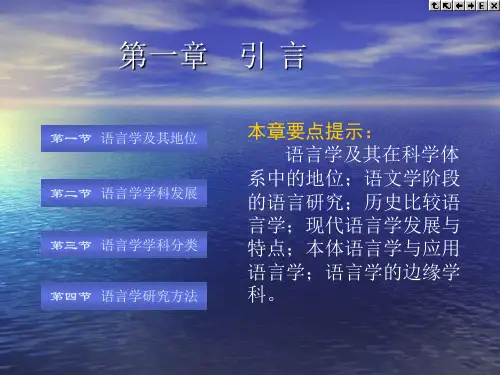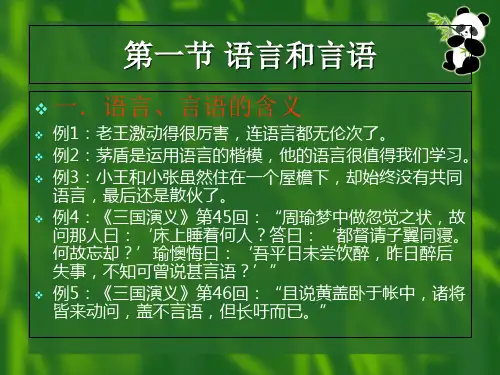第一章语言与语言学介绍PPT课件
- 格式:ppt
- 大小:866.00 KB
- 文档页数:12
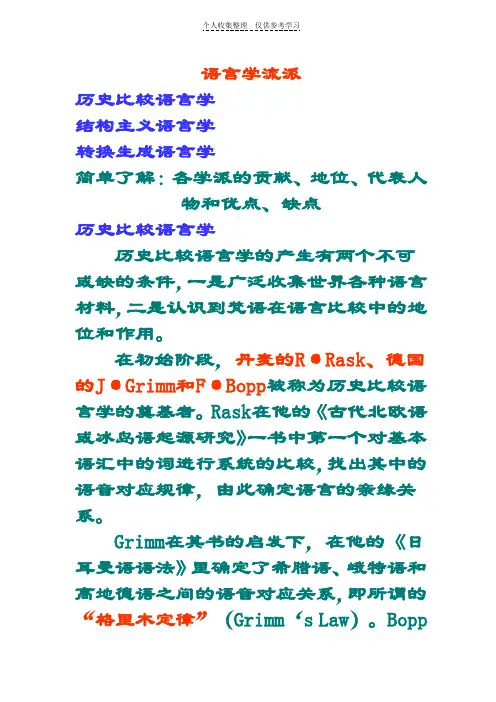
语言学流派历史比较语言学结构主义语言学转换生成语言学简单了解:各学派的贡献、地位、代表人物和优点、缺点历史比较语言学历史比较语言学的产生有两个不可或缺的条件,一是广泛收集世界各种语言材料,二是认识到梵语在语言比较中的地位和作用。
在初始阶段,丹麦的R·Rask、德国的J·Grimm和F·Bopp被称为历史比较语言学的奠基者。
Rask在他的《古代北欧语或冰岛语起源研究》一书中第一个对基本语汇中的词进行系统的比较,找出其中的语音对应规律,由此确定语言的亲缘关系。
Grimm在其书的启发下,在他的《日耳曼语语法》里确定了希腊语、峨特语和高地德语之间的语音对应关系,即所谓的“格里木定律”(Grimm‘s Law)。
Bopp的主要著作是《梵语、禅德语、亚美尼亚语、希腊语、拉丁语、立陶宛语、古斯拉夫语、峨特语和德语比较语法》,旨在把梵语和欧洲、亚洲的几种其他语言相比较,找出它们在形态上的共同来源。
历史比较语言学发展到第二阶段,最有代表性的人物是德国的施莱歇尔(August Schleicher),其代表作是《印度日耳曼语系语言比较语法纲要》。
他受到生物学物种分类的启发,为有亲属关系的语言的历史演变过程设计了一种树形谱系图,使语言之间的亲属关系以直观的形式呈现在人们的面前。
这是历史比较语言学的一大进展。
19世纪的最后25年是历史比较语言学的“新语法学派”时期。
这个学派的代表人物是奥斯特霍夫H·Osthoff)和布鲁克曼(K·Brugmann),他们在自己创办的刊物《形态学研究》上正式宣布:语音演变规律不允许任何例外。
他们在坚持这个原则时,以语言材料为依据,借鉴生理学和心理学的研究成果,强调“类推”在语言演变中的作用。
这个学派的代表著作有布鲁克曼和德尔布吕克合著的《印度日耳曼语比较语法纲要》和保罗的《语言史原理》。
19世纪历史比较语言学家为语言学的发展做出了重要贡献。


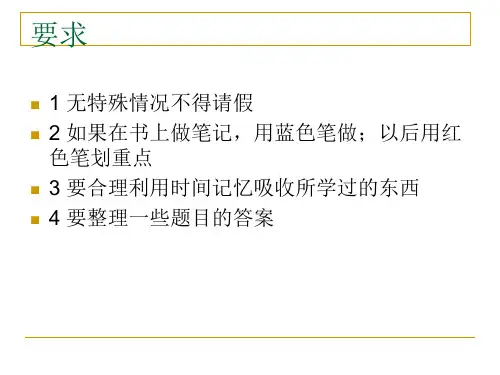



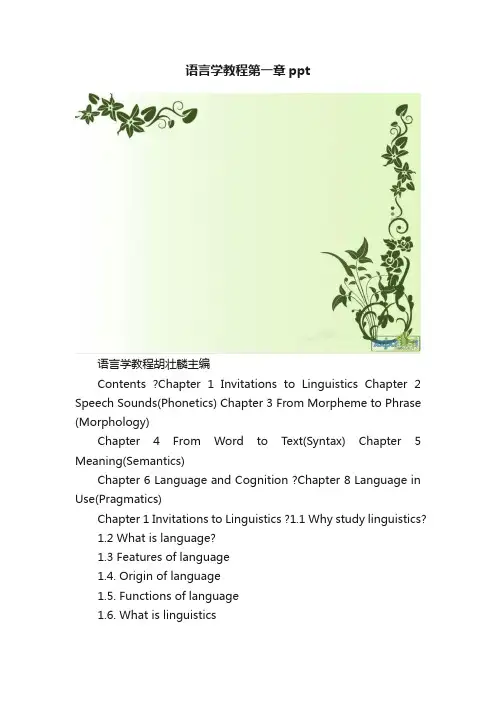
语言学教程第一章ppt语言学教程胡壮麟主编Contents ?Chapter 1 Invitations to Linguistics Chapter 2 Speech Sounds(Phonetics) Chapter 3 From Morpheme to Phrase (Morphology)Chapter 4 From Word to Text(Syntax) Chapter 5 Meaning(Semantics)Chapter 6 Language and Cognition ?Chapter 8 Language in Use(Pragmatics)Chapter 1 Invitations to Linguistics ?1.1 Why study linguistics?1.2 What is language?1.3 Features of language1.4. Origin of language1.5. Functions of language1.6. What is linguistics1.7 Main branches of linguistics1.8. Macrolinguistics1.9 Important distinctions in linguisticsLead-inQestion1: Other animals can beat us in many different ways, but what makes us superior to all of them?Qestion2: Why are children easy to undrstand their mother's tongue??Qestion3: Why do people in different social classes speak in different ways??Qestion4: Why is it "I love you" in English, but "私はあなたを愛して" in Japanese?1.2 What is language ?Language is a system of arbitrary vocal symbols used for human communication.__ by (英)沃德霍(Wardhaugh,R.)1.3 Design Features of languageArbitrarinessDualityCreativityDisplacement1.3.1 Arbitrariness ?Arbitrariness: the forms of linguistic signs bear no natural relationship to their meaning –Saussure.Eg: name,book,pen(1) Arbitrary relationship between the sound of a morpheme and its meaning.Eg: Hi, Aha,Hush, Hem, Hey.(2) Arbitrariness at the syntactic level: according to systemic-functionalists and American functionalists, language is not arbitrary at the syntactic level. In other words, syntax is less arbitrary than words.Eg: He came in and sat down.(3) Idiom is not arbitrary.Eg: apple-polisher, black sheep, a yellow dog.1.3.2 DualityDuality (double articulation)Lower level----sounds (meaningless Eg: Consonants and Vowels)Higher level----meaning (larger units of meaning Eg: word)A communication system with duality is considered more flexible than one without it, for a far greater number of messages can be sent.A small number of sounds can be grouped and regrouped into a large number of units of meaning (words), and the units of meaning can be arranged and rearranged into an infinite number of sentences. (we make dictionary of a1.3.3 CreativityPeculiar to human languages,users of language can understand and produce sentences they have never heard before, e.g. we can understand sentence like “A red-eyed elephant is dancing on the hotel bed”, though it does not describe a common happening in the world.Eg: 说曹操曹操到(not refer to Cao Cao himself)1.3.4 Displacement----Language can be used to refer to things, which are not present: real or imagined matters, in the past, present or future, or in far-away places.Eg: 911 events , New York1.4. Origin of language语言的起源是语言学的基本理论问题之一。
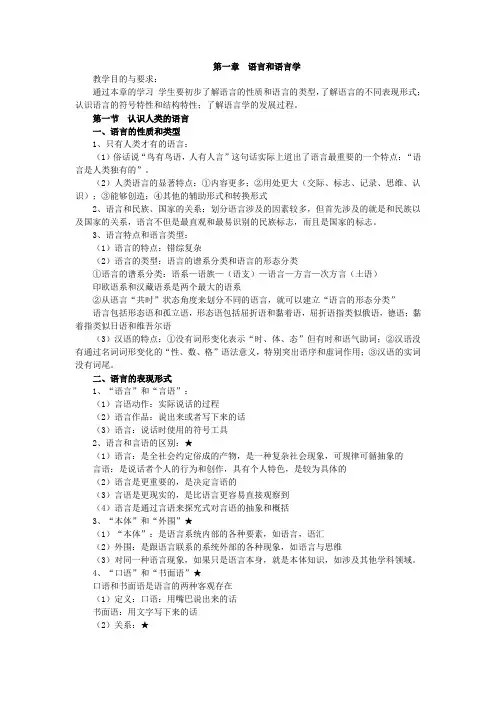
第一章语言和语言学教学目的与要求:通过本章的学习学生要初步了解语言的性质和语言的类型,了解语言的不同表现形式;认识语言的符号特性和结构特性;了解语言学的发展过程。
第一节认识人类的语言一、语言的性质和类型1、只有人类才有的语言:(1)俗话说“鸟有鸟语,人有人言”这句话实际上道出了语言最重要的一个特点:“语言是人类独有的”。
(2)人类语言的显著特点:①内容更多;②用处更大(交际、标志、记录、思维、认识);③能够创造;④其他的辅助形式和转换形式2、语言和民族、国家的关系:划分语言涉及的因素较多,但首先涉及的就是和民族以及国家的关系,语言不但是最直观和最易识别的民族标志,而且是国家的标志。
3、语言特点和语言类型:(1)语言的特点:错综复杂(2)语言的类型:语言的谱系分类和语言的形态分类①语言的谱系分类:语系—语族—(语支)—语言—方言—次方言(土语)印欧语系和汉藏语系是两个最大的语系②从语言“共时”状态角度来划分不同的语言,就可以建立“语言的形态分类”语言包括形态语和孤立语,形态语包括屈折语和黏着语,屈折语指类似俄语,德语;黏着指类似日语和维吾尔语(3)汉语的特点:①没有词形变化表示“时、体、态”但有时和语气助词;②汉语没有通过名词词形变化的“性、数、格”语法意义,特别突出语序和虚词作用;③汉语的实词没有词尾。
二、语言的表现形式1、“语言”和“言语”:(1)言语动作:实际说话的过程(2)语言作品:说出来或者写下来的话(3)语言:说话时使用的符号工具2、语言和言语的区别:★(1)语言:是全社会约定俗成的产物,是一种复杂社会现象,可规律可循抽象的言语:是说话者个人的行为和创作,具有个人特色,是较为具体的(2)语言是更重要的,是决定言语的(3)言语是更现实的,是比语言更容易直接观察到(4)语言是通过言语来探究式对言语的抽象和概括3、“本体”和“外围”★(1)“本体”:是语言系统内部的各种要素,如语言,语汇(2)外围:是跟语言联系的系统外部的各种现象,如语言与思维(3)对同一种语言现象,如果只是语言本身,就是本体知识,如涉及其他学科领域。
